Beach Profile Evolution towards Equilibrium from Varying Initial Morphologies
Abstract
1. Introduction
2. Experimental Setup
2.1. Wave Condition E2
2.2. Measurements
2.3. Initial Conditions
3. Data Analysis
3.1. Sediment Transport Calculated from Bed Profile Measurements
3.2. Data Treatment
3.3. Bed Level Changes from AWG Measurements
4. Results
4.1. Profile Evolution
4.2. Sediment Transport
4.3. Wave Heights along the Flume
4.4. Time-Averaged Velocities
4.5. Bed Level Changes during the First Run in the Swash Zone
5. Conceptual Model and Discussion
6. Conclusions
- The beach evolves towards the same final (equilibrium) morphology that is determined by the wave condition. Different initial beach morphologies do not alter this equilibrium beach morphology but produce different sediment transport patterns, associated with differences in the hydrodynamics, to reach the equilibrium morphology.
- Differences in the profile morphology and hydrodynamics are largest during the first 30 min run, highlighting an important coupling between the beach morphology and the hydrodynamics. When the beach profile is more stable (from the second wave run), the hydrodynamic differences that arise from the different beach morphologies, diminish and more detailed measurements would be needed to investigate effects of morphodynamic coupling on equilibrium beach evolution on a more detailed scale.
- The bar of the initial profile—and, more specifically, its size and location—presents an important morphological feature for the equilibrium beach evolution. The size and location of the bar determine if the bar controls the wave breaking location and associated wave energy dissipation. In case of an intermediate energy profile with an existing breaker bar, wave energy dissipation is confined around the bar in a narrow zone leading to offshore sediment transport in this region and providing a sheltering effect for the inner surf and swash zone. In case of a low energy profile, the initial bar does not control the wave breaking location and wave energy dissipation occurs over a wider cross-shore region associated with offshore sediment transport.
- The large swash berm of the initial low energy profile plays an important role for the equilibrium beach evolution. The berm presents a large source of sediment which is partly moved onshore to fill up the runnel and partly moved offshore towards the breaker bar. Mean velocities are small at the berm crest with onshore sediment transport rates and accelerate quickly towards the toe of the berm with large offshore sediment transport rates.
- A conceptual model is developed that brings together the most important aspects of the coupling between morphology and hydrodynamics for equilibrium beach evolution for the same incident wave condition but varying initial morphologies. The conceptual model accounts for two importantly different initial morphologies—an intermediate energy and a low energy profile—and accounts for various aspects, including the breaker bar, wave energy dissipation, sediment transport, mean flow velocities and berm decay.
Author Contributions
Funding
Acknowledgments
Conflicts of Interest
Abbreviations
| RESIST | Influence of Storm Sequencing and Beach Recovery on Sediment Transport and Beach Resilience (project title) |
| RWG | Resistive wave gauge |
| AWG | Acoustic wave gauge |
| ADV | Acoustic doppler velocimeter |
| LBT | Longshore bar–trough (beach state) |
| RBB | Rhythmic bar and beach (beach state) |
| RR | Ridge-runnel (beach state) |
| SWL | Still water level |
References
- Short, A.D. Beaches. In Handbook of Beach and Shoreface Morphodynamics; Short, A.D., Ed.; John Wiley & Sons: New York, NY, USA, 1999. [Google Scholar]
- Wright, L.D.; Thom, B.G. Coastal depositional landforms: A morphodynamic approach. Prog. Phys. Geogr. 1977, 3, 412–459. [Google Scholar] [CrossRef]
- Zhou, Z.; Coco, G.; Townend, I.; Olabarrieta, M.; van der Wegen, M.; Gong, Z.; D’Alpaos, A.; Gao, S.; Jaffe, B.E.; Gelfenbaum, G.; et al. Is “Morphodynamic Equilibrium” an oxymoron? Earth-Sci. Rev. 2017, 165, 257–267. [Google Scholar] [CrossRef]
- Wright, L.D.; Short, A.D.; Green, M.O. Short-term changes in the morphodynamic states of beaches and surf zones: An empirical predictive model. Mar. Geol. 1985, 62, 339–364. [Google Scholar] [CrossRef]
- Ashton, A.; Murray, A.B.; Arnouldt, O. Formation of coastline features by large-scale instabilities induced by high-angle waves. Nature 2001, 414, 296–300. [Google Scholar] [CrossRef] [PubMed]
- Miller, J.K.; Dean, R.G. A simple new shoreline change model. Coast. Eng. 2004, 51, 531–556. [Google Scholar] [CrossRef]
- Yates, M.L.; Guza, R.T.; O’Reilly, W.C. Equilibrium shoreline response: Observations and modeling. J. Geophys. Res. Ocean. 2009, 114, 1–16. [Google Scholar] [CrossRef]
- Davidson, M.A.; Splinter, K.D.; Turner, I.L. A simple equilibrium model for predicting shoreline change. Coast. Eng. 2013, 73, 191–202. [Google Scholar] [CrossRef]
- Wright, L.D.; Short, A.D. Morphodynamic variability of surf zones and beaches: A synthesis. Mar. Geol. 1984, 56, 93–118. [Google Scholar] [CrossRef]
- Gallagher, E.L.; Elgar, S.; Guza, R.T. Observations of sand bar evolution on a natural beach. J. Geophys. Res. 1998, 103, 3203–3215. [Google Scholar] [CrossRef]
- Hoefel, F.; Elgar, S. Wave-induced sediment transport and sandbar migration. Science 2003, 299, 1885–1887. [Google Scholar] [CrossRef] [PubMed]
- Mariño-Tapia, I.J.; Russell, P.E.; O’Hare, T.J.; Davidson, M.A.; Huntley, D.A. Cross-shore sediment transport on natural beaches and its relation to sandbar migration patterns: 1. Field observations and derivation of a transport parameterization. J. Geophys. Res. Ocean. 2007, 112. [Google Scholar] [CrossRef]
- Eichentopf, S.; Cáceres, I.; Alsina, J.M. Breaker bar morphodynamics under erosive and accretive wave conditions in large-scale experiments. Coast. Eng. 2018, 138, 36–48. [Google Scholar] [CrossRef]
- Baldock, T.E.; Birrien, F.; Atkinson, A.; Shimamoto, T.; Wu, S.; Callaghan, D.P.; Nielsen, P. Morphological hysteresis in the evolution of beach profiles under sequences of wave climates—Part 1; observations. Coast. Eng. 2017, 128, 92–105. [Google Scholar] [CrossRef]
- Weir, F.M.; Hughes, M.G.; Baldock, T.E. Beach face and berm morphodynamics fronting a coastal lagoon. Geomorphology 2006, 82, 331–346. [Google Scholar] [CrossRef]
- Jackson, N.L.; Masselink, G.; Nordstrom, K.F. The role of bore collapse and local shear stresses on the spatial distribution of sediment load in the uprush of an intermediate-state beach. Mar. Geol. 2004, 203, 109–118. [Google Scholar] [CrossRef]
- Alsina, J.M.; Baldock, T.E.; Hughes, M.G.; Weir, F.; Sierra, J.P. Sediment transport numerical modelling in the swash zone. In Proceedings of the Fifth International Conference on Coastal Dynamics (’05), Barcelona, Spain, 4–8 April 2005. [Google Scholar] [CrossRef]
- Alsina, J.M.; van der Zanden, J.; Cáceres, I.; Ribberink, J.S. The influence of wave groups and wave-swash interactions on sediment transport and bed evolution in the swash zone. Coast. Eng. 2018, 140, 23–42. [Google Scholar] [CrossRef]
- Grasso, F.; Michallet, H.; Barthélemy, E.; Certain, R. Physical modeling of intermediate cross-shore beach morphology: Transients and equilibrium states. J. Geophys. Res. Ocean. 2009, 114. [Google Scholar] [CrossRef]
- Birrien, F.; Atkinson, A.; Shimamoto, T.; Baldock, T.E. Hysteresis in the evolution of beach profile parameters under sequences of wave climates—Part 2; Modelling. Coast. Eng. 2018, 133, 13–25. [Google Scholar] [CrossRef]
- Eichentopf, S.; van der Zanden, J.; Cáceres, I.; Baldock, T.E.; Alsina, J.M. Influence of storm sequencing on breaker bar and shoreline evolution in large-scale experiments. Coast. Eng. 2019. in review. [Google Scholar]
- Scott, T.; Masselink, G.; O’Hare, T.; Saulter, A.; Poate, T.; Russell, P.; Davidson, M.; Conley, D. The extreme 2013/2014 winter storms: Beach recovery along the southwest coast of England. Mar. Geol. 2016, 382, 224–241. [Google Scholar] [CrossRef]
- Biausque, M.; Senechal, N. Seasonal morphological response of an open sandy beach to winter wave conditions: The example of Biscarrosse beach, SW France. Geomorphology 2019, 332, 157–169. [Google Scholar] [CrossRef]
- Grasso, F.; Michallet, H.; Barthélemy, E. Experimental simulation of shoreface nourishments under storm events: A morphological, hydrodynamic, and sediment grain size analysis. Coast. Eng. 2011, 58, 184–193. [Google Scholar] [CrossRef]
- Eichentopf, S.; Karunarathna, H.; Alsina, J.M. Morphodynamics of sandy beaches under the influence of storm sequences—Current research status and future needs. Water Sci. Eng. 2019, 12, 221–234. [Google Scholar] [CrossRef]
- Coco, G.; Senechal, N.; Rejas, A.; Bryan, K.R.; Capo, S.; Parisot, J.P.; Brown, J.A.; MacMahan, J.H.M. Beach response to a sequence of extreme storms. Geomorphology 2014, 204, 493–501. [Google Scholar] [CrossRef]
- Morales-Márquez, V.; Orfila, A.; Simarro, G.; Gómez-Pujol, L.; Álvarez-Ellacuría, A.; Conti, D.; Galán, A.; Osorio, A.F.; Marcos, M. Numerical and remote techniques for operational beach management under storm group forcing. Nat. Hazards Earth Syst. Sci. 2018, 18, 3211–3223. [Google Scholar] [CrossRef]
- Eichentopf, S.; Baldock, T.E.; Cáceres, I.; Hurther, D.; Karunarathna, H.; Postacchini, M.; Ranieri, N.; van der Zanden, J.; Alsina, J.M. Influence of storm sequencing and beach recovery on sediment transport and beach resilience (RESIST). In Proceedings of the HYDRALAB+ Joint User Meeting, Bucharest, Romania, 21–25 May 2019; Available online: https://hydralab.eu/assets/Proceedings-Hydralab-Joint-User-Meeting-May-23-Bucharest.pdf (accessed on 1 June 2019).
- Van der Zanden, J.; Cáceres, I.; Eichentopf, S.; Ribberink, J.S.; van der Werf, J.J.; Alsina, J.M. Sand transport processes and bed level changes induced by two alternating laboratory swash events. Coast. Eng. 2019, 152, 103519. [Google Scholar] [CrossRef]
- Baldock, T.E.; Alsina, J.M.; Caceres, I.; Vicinanza, D.; Contestabile, P.; Power, H.; Sanchez-Arcilla, A. Large-scale experiments on beach profile evolution and surf and swash zone sediment transport induced by long waves, wave groups and random waves. Coast. Eng. 2011, 58, 214–227. [Google Scholar] [CrossRef]
- Alsina, J.M.; Padilla, E.M.; Cáceres, I. Sediment transport and beach profile evolution induced by bi-chromatic wave groups with different group periods. Coast. Eng. 2016, 114, 325–340. [Google Scholar] [CrossRef]
- Van der Zanden, J.; van der A, D.A.; Cáceres, I.; Hurther, D.; McLelland, S.J.; Ribberink, J.S.; O’Donoghue, T. Near-Bed Turbulent Kinetic Energy Budget Under a Large-Scale Plunging Breaking Wave Over a Fixed Bar. J. Geophys. Res. Ocean. 2018, 123, 1429–1456. [Google Scholar] [CrossRef]
- Svendsen, I.A.; Madsen, P.A.; Buhr Hansen, J. Wave characteristics in the surf zone. In Proceedings of the 16th International Conference on Coastal Engineering, Hamburg, Germany, 27 August–3 September 1978; pp. 520–539. [Google Scholar] [CrossRef]
- Peregrine, D.H. Breaking waves on beaches. Annu. Rev. Fluid Mech. 1983, 15, 149–178. [Google Scholar] [CrossRef]
- Elfrink, B.; Baldock, T. Hydrodynamics and sediment transport in the swash zone: A review and perspectives. Coast. Eng. 2002, 45, 149–167. [Google Scholar] [CrossRef]
- Turner, I.L.; Russell, P.E.; Butt, T. Measurement of wave-by-wave bed-levels in the swash zone. Coast. Eng. 2008, 55, 1237–1242. [Google Scholar] [CrossRef]
- Alsina, J.M.; Cáceres, I.; Brocchini, M.; Baldock, T.E. An experimental study on sediment transport and bed evolution under different swash zone morphological conditions. Coast. Eng. 2012, 68, 31–43. [Google Scholar] [CrossRef]
- Almar, R.; Castelle, B.; Ruessink, B.G.; Sénéchal, N.; Bonneton, P.; Marieu, V. Two- and three-dimensional double-sandbar system behaviour under intense wave forcing and a meso-macro tidal range. Cont. Shelf Res. 2010, 30, 781–792. [Google Scholar] [CrossRef]
- Pape, L.; Plant, N.G.; Ruessink, B.G. On cross-shore migration and equilibrium states of nearshore sandbars. J. Geophys. Res. Earth Surf. 2010, 115. [Google Scholar] [CrossRef]
- Elgar, S.; Gallagher, E.; Guza, R. Nearshore sandbar migration. J. Geophys. Res. 2001, 106, 11623–11627. [Google Scholar] [CrossRef]
- Fernández-Mora, A.; Calvete, D.; Falqués, A.; de Swart, H.E. Onshore sandbar migration in the surf zone: New insights into the wave induced sediment transport mechanisms. Geophys. Res. Lett. 2015, 2869–2877. [Google Scholar] [CrossRef]
- Van der Zanden, J.; van der A, D.A.; Hurther, D.; Cáceres, I.; O’Donoghue, T.; Hulscher, S.J.M.H.; Ribberink, J.S. Bedload and suspended load contributions to breaker bar morphodynamics. Coast. Eng. 2017, 129, 74–92. [Google Scholar] [CrossRef]
- Aagaard, T.; Hughes, M.; Møller-Sørensen, R.; Andersen, S. Hydrodynamics and sediment fluxes across an onshore migrating intertidal bar. J. Coast. Res. 2006, 222, 247–259. [Google Scholar] [CrossRef]
- Van der Zanden, J.; Alsina, J.M.; Cáceres, I.; Buijsrogge, R.H.; Ribberink, J.S. Bed level motions and sheet flow processes in the swash zone: Observations with a new conductivity-based concentration measuring technique (CCM+). Coast. Eng. 2015, 105, 47–65. [Google Scholar] [CrossRef]
- Ruiz de Alegría-Arzaburu, A.; Mariño-Tapia, I.; Silva, R.; Pedrozo-Acuña, A. Post-nourishment beach scarp morphodynamics. J. Coast. Res. 2013, 576–581. [Google Scholar] [CrossRef]
- Bonte, Y.; Levoy, F. Field experiments of beach scarp erosion during oblique wave, stormy conditions (Normandy, France). Geomorphology 2015, 236, 132–147. [Google Scholar] [CrossRef]
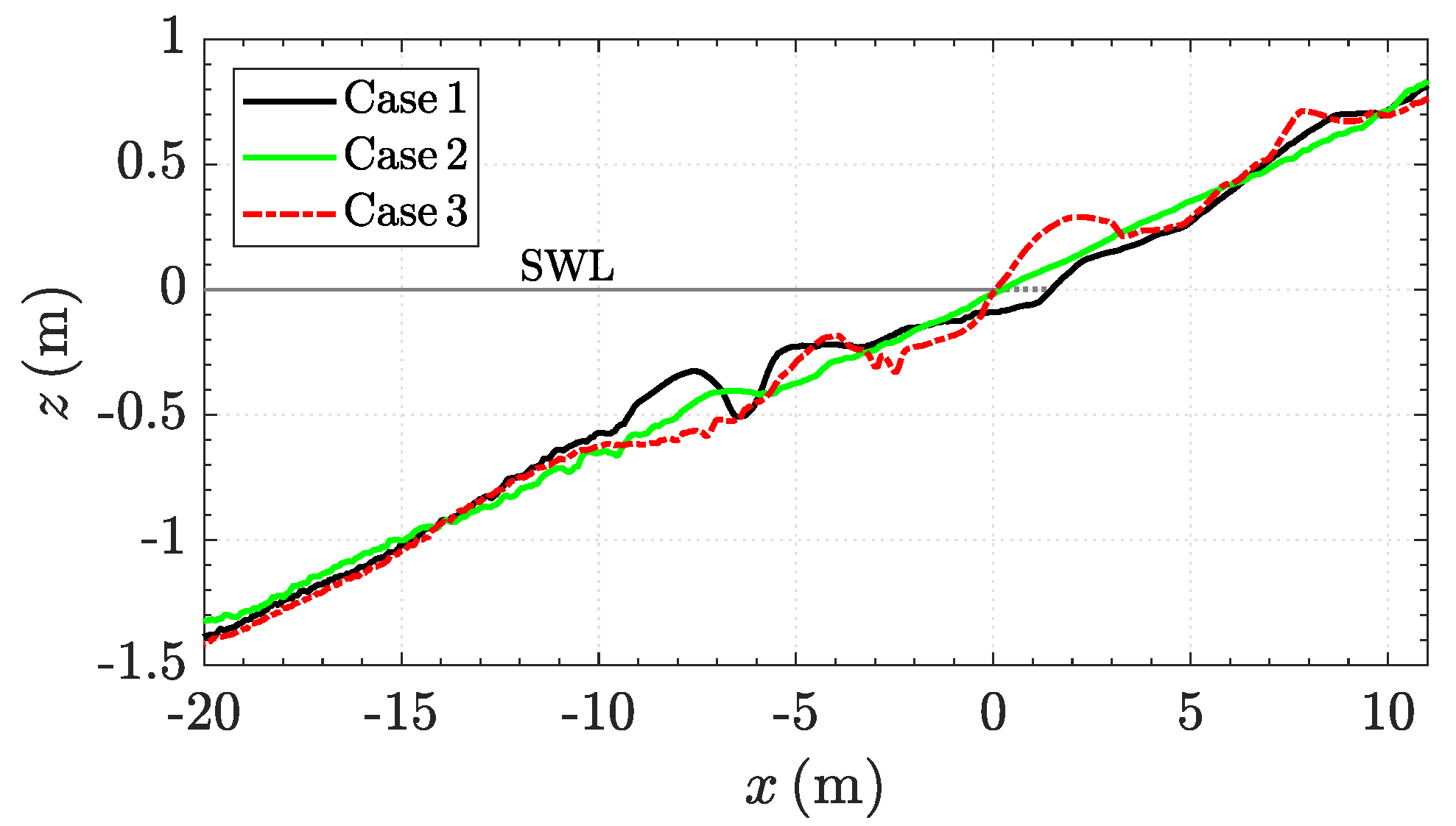
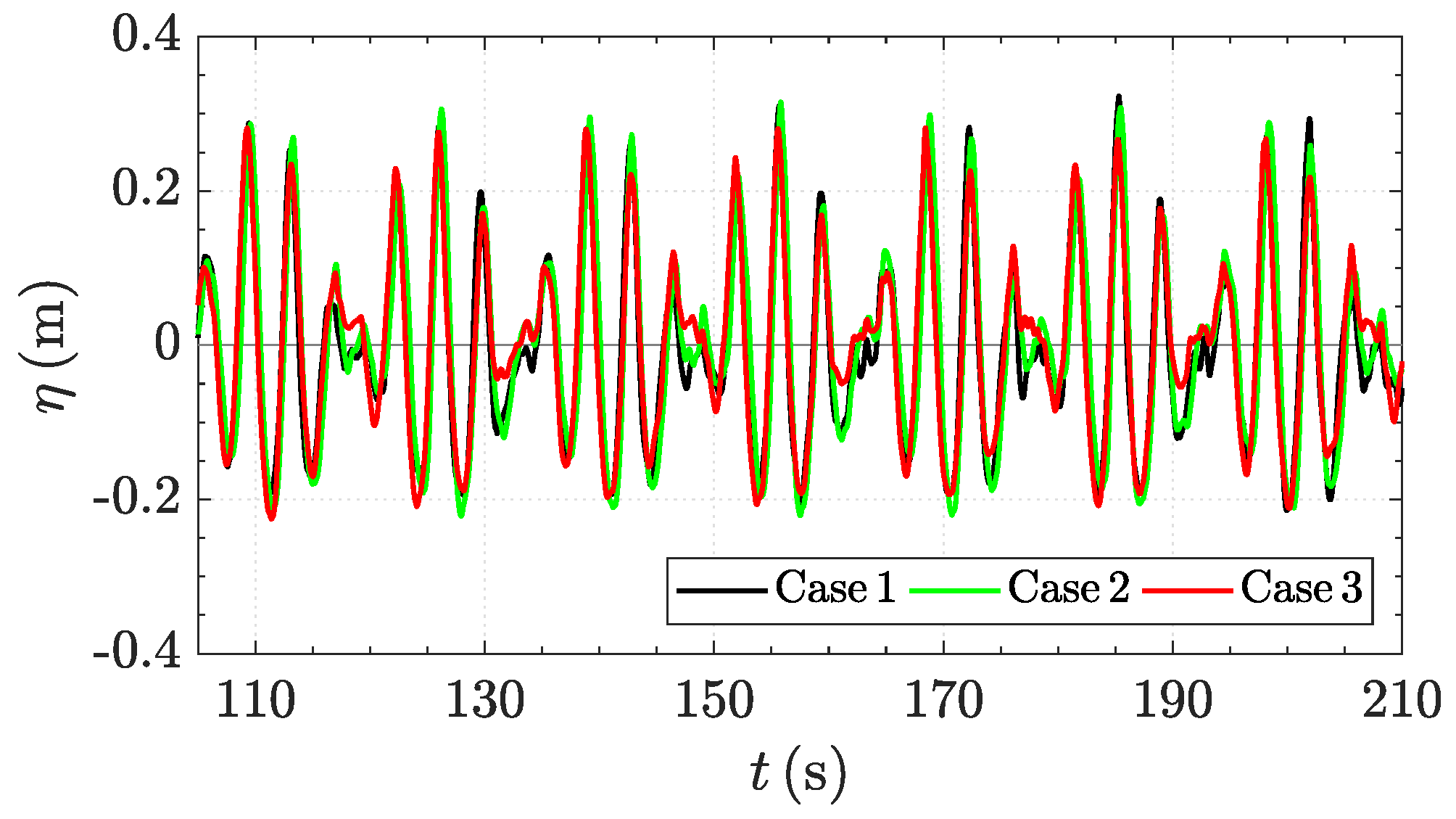
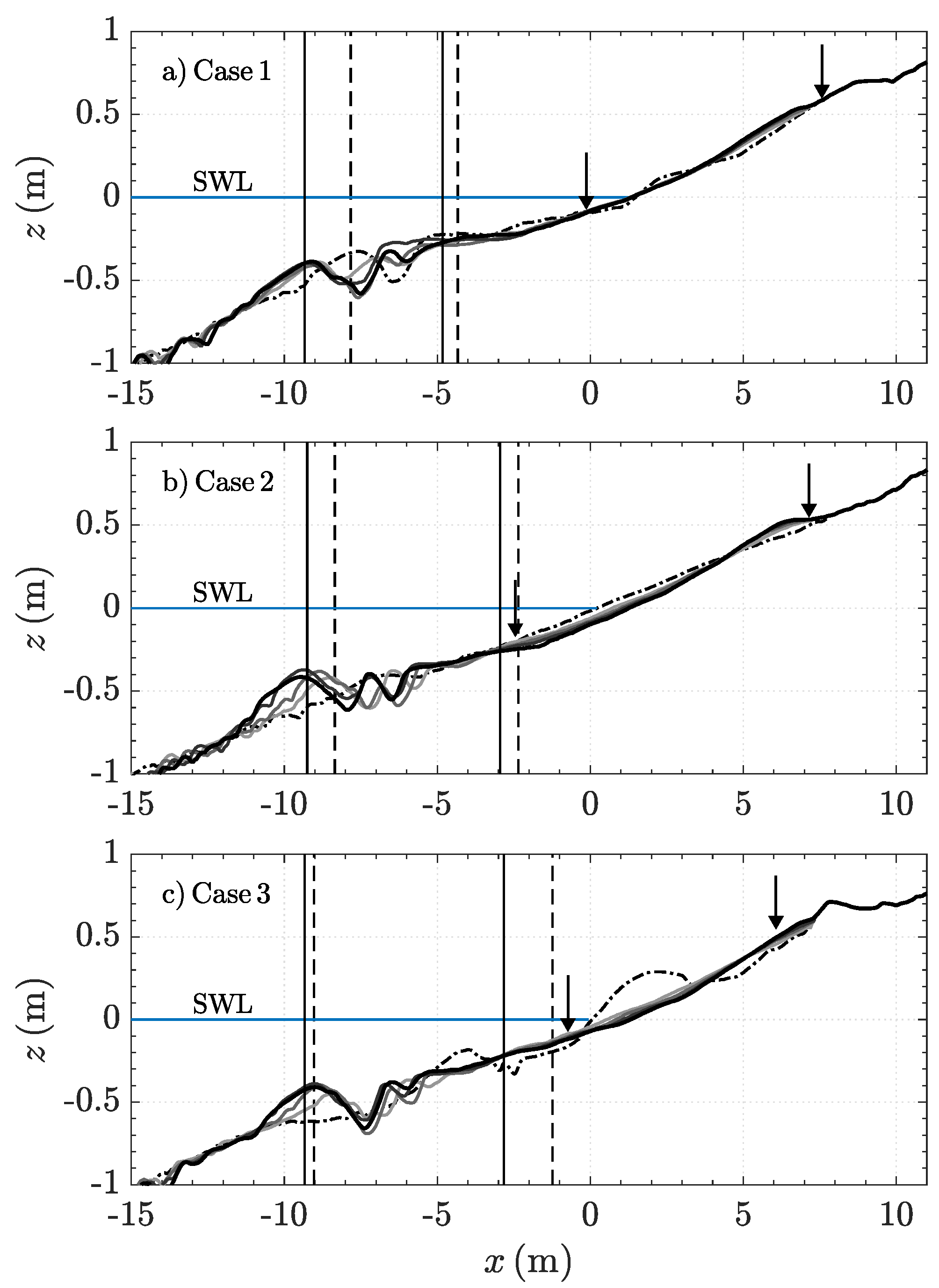
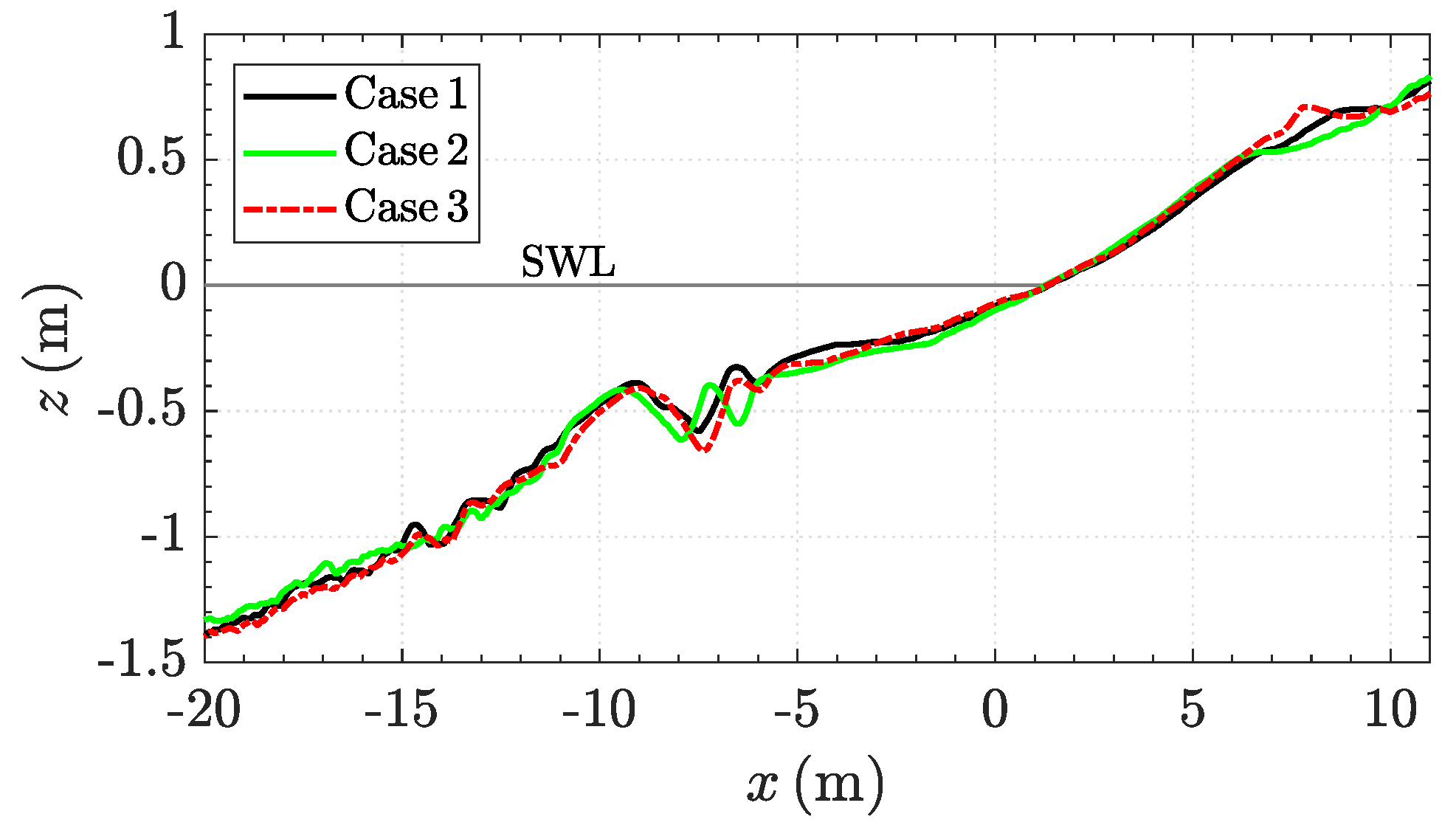
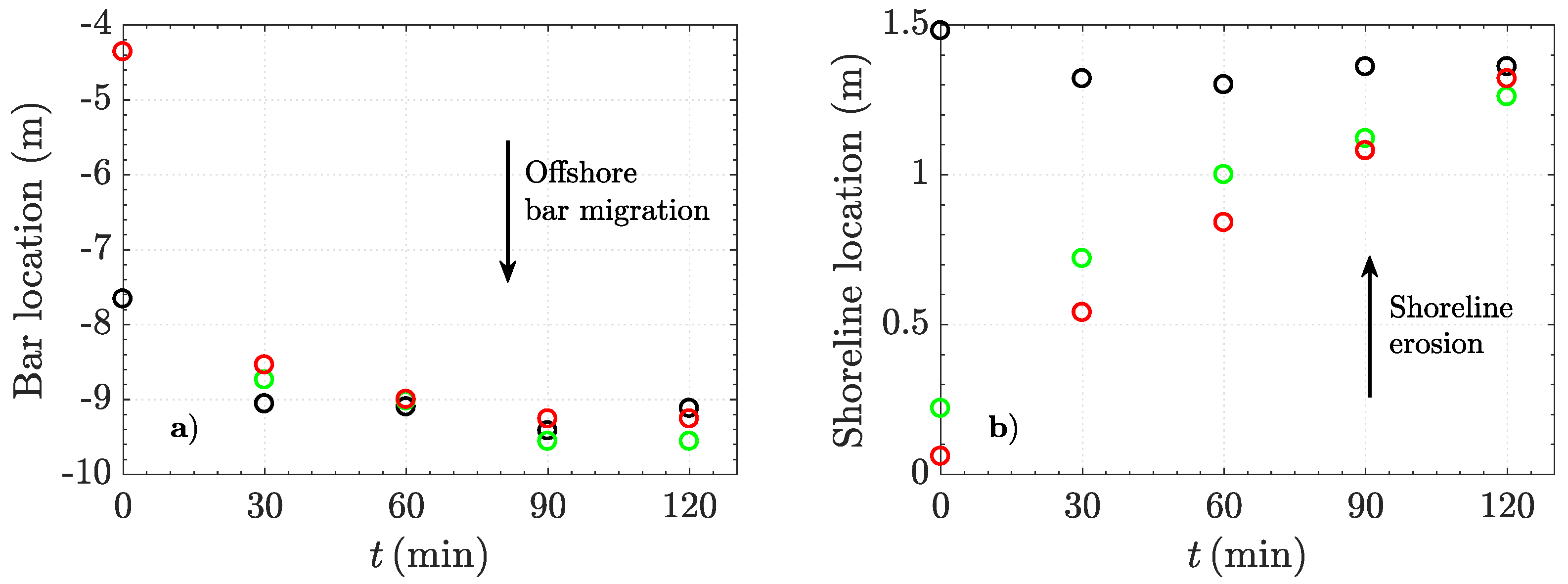
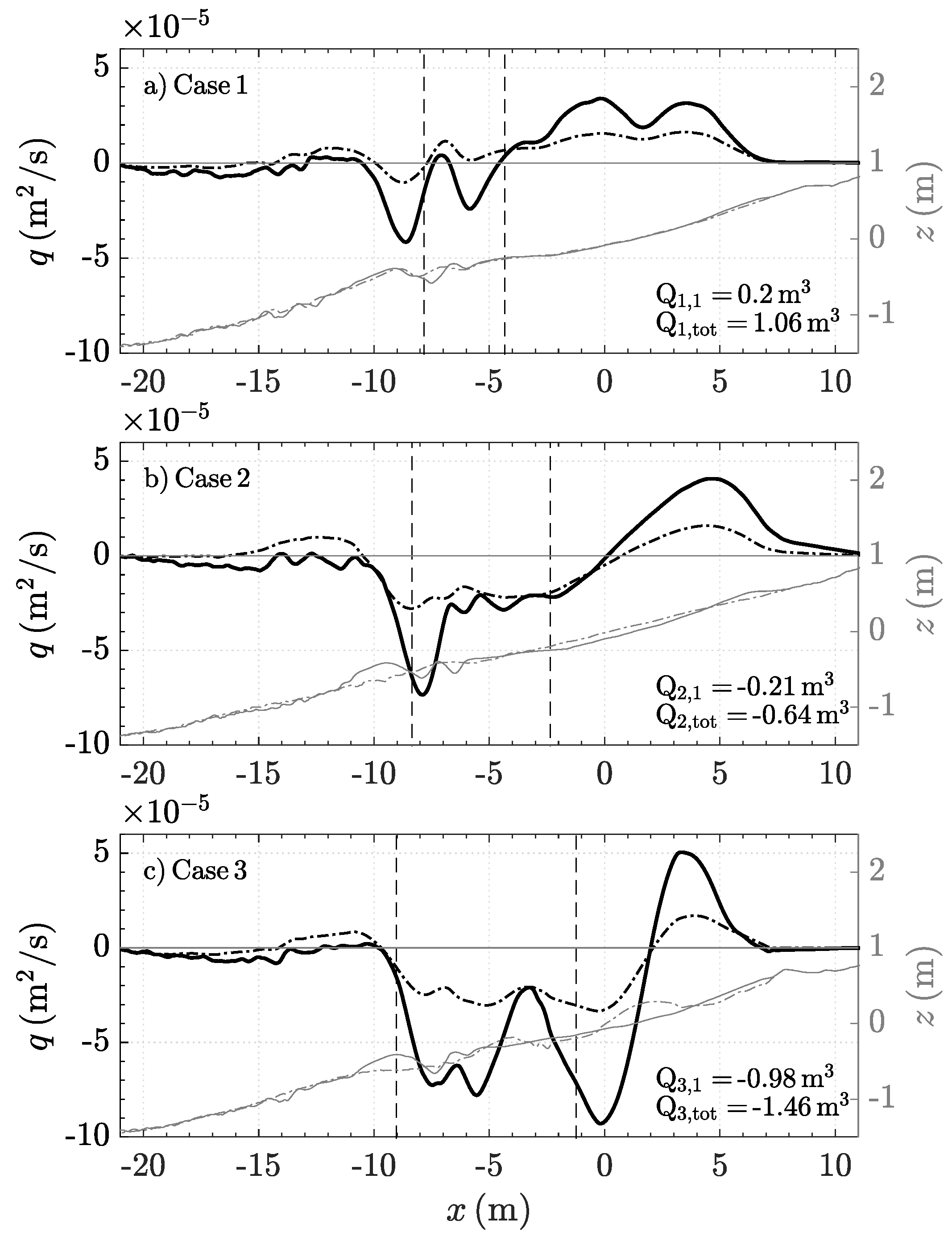
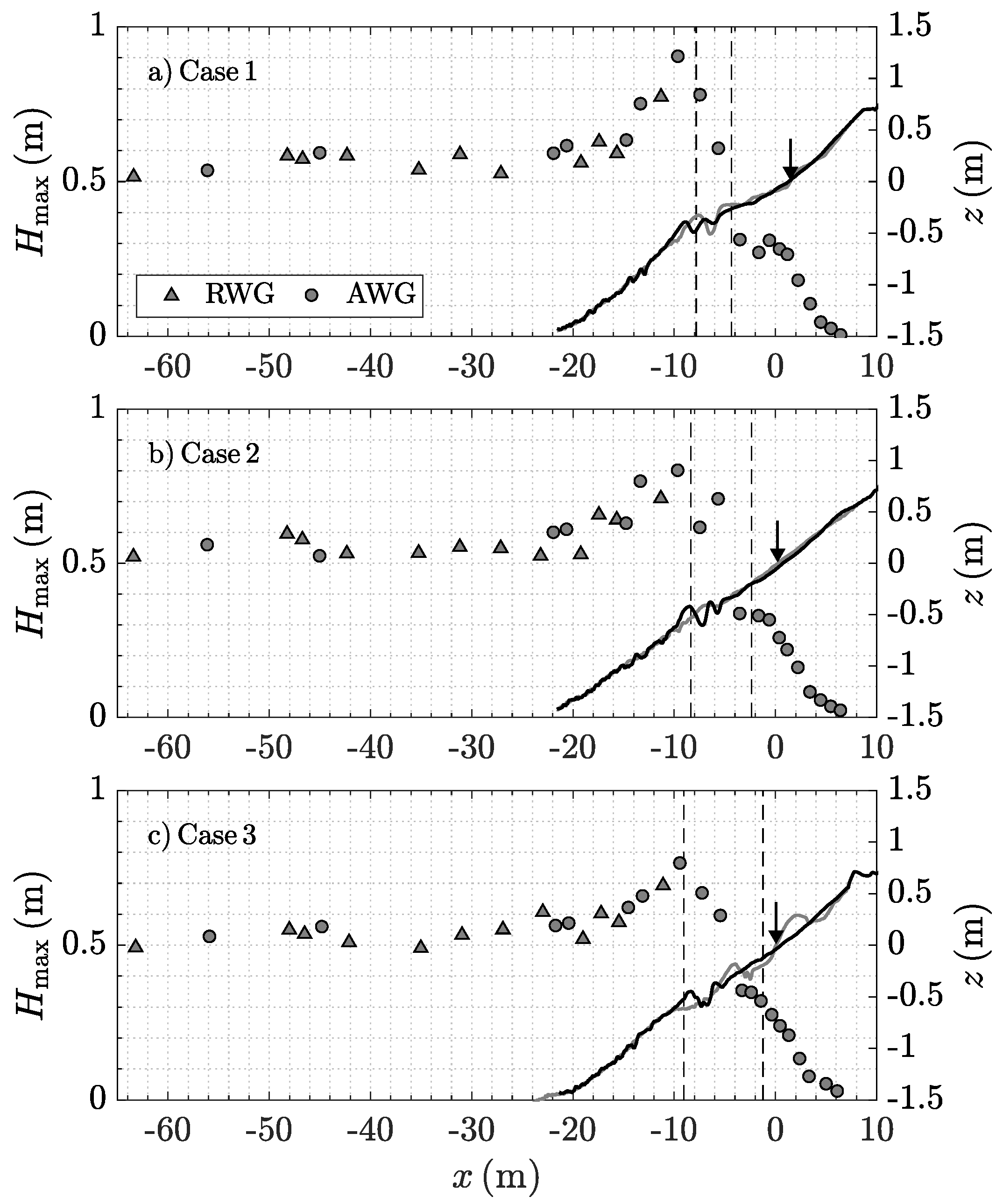

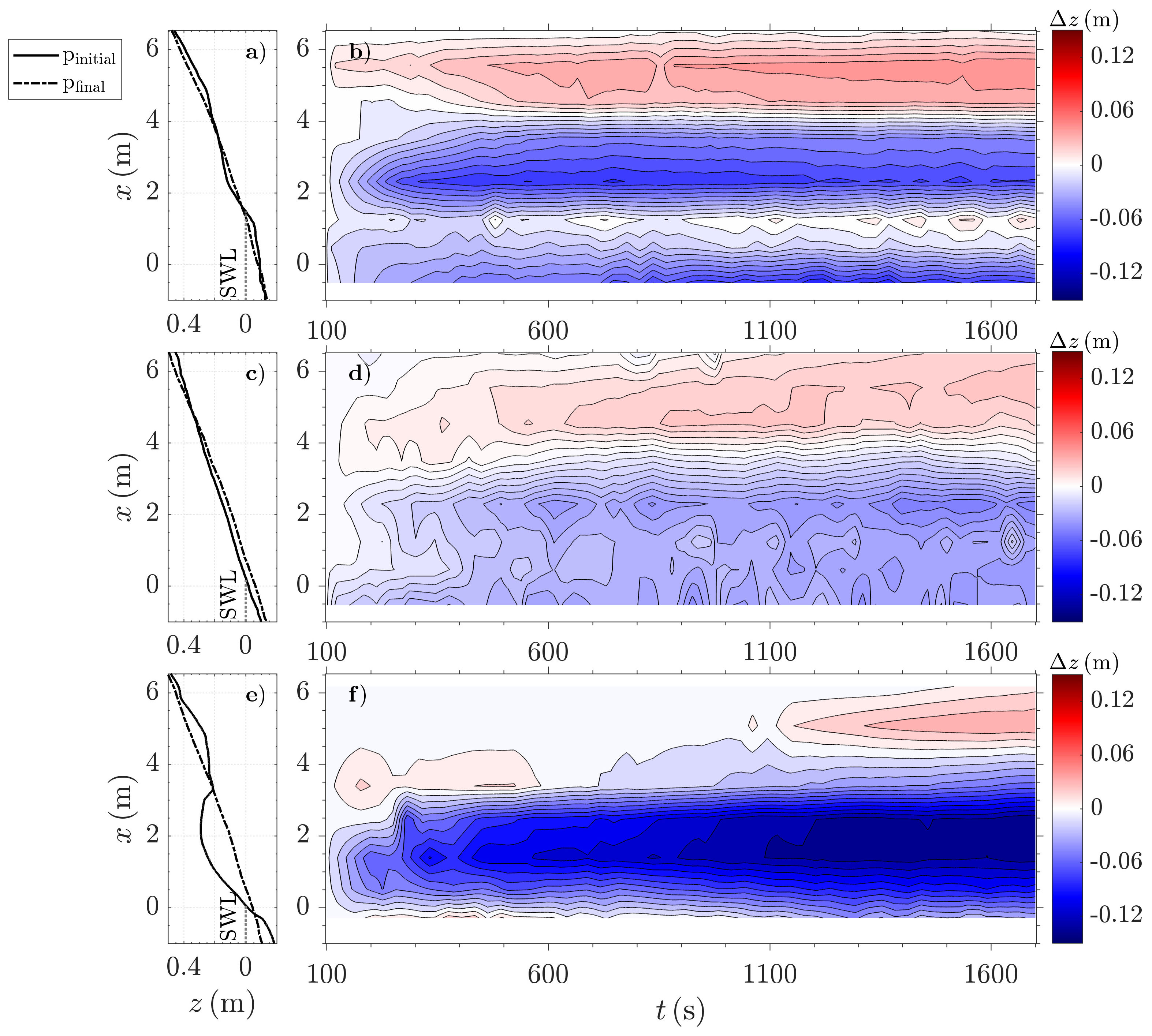
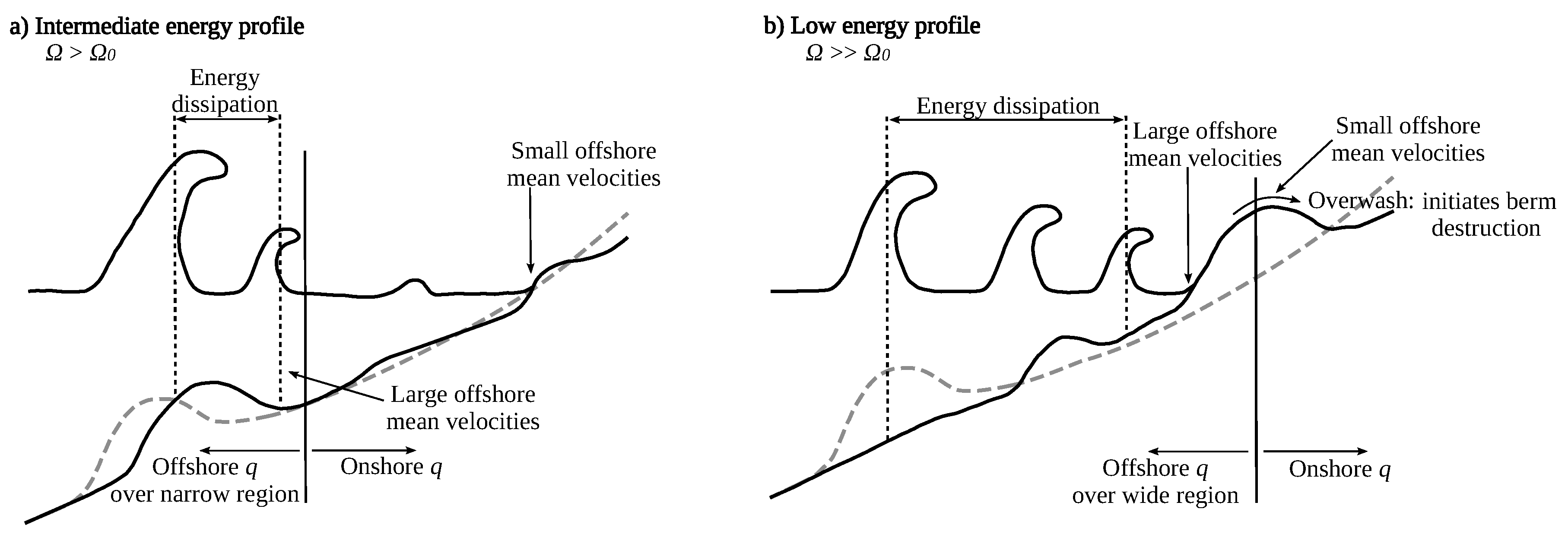
| Sequence 1 | Sequence 2 | Sequence 3 | ||||||
|---|---|---|---|---|---|---|---|---|
| Condition | Duration (min) | (-) | Condition | Duration (min) | (-) | Condition | Duration (min) | (-) |
| B | 30 | 3.09 | B | 30 | 3.09 | B | 30 | 3.09 |
| E1 | 240 | 5.09 | E2 | 120 | 3.90 | E1 | 240 | 5.09 |
| A1 | 600 | 2.00 | A1 | 600 | 2.00 | A2 | 780 | 1.50 |
| E2 | 120 | 3.90 | E1 | 240 | 5.09 | E2 | 120 | 3.90 |
| A1 | 600 | 2.00 | A1 | 600 | 2.00 | A3 | 1440 | 1.03 |
| (m) | (Hz) | (m) | (Hz) | (m) | (s) | (s) | (s) |
|---|---|---|---|---|---|---|---|
| 0.245 | 0.3041 | 0.245 | 0.2365 | 0.49 | 3.7 | 14.8 | 29.6 |
| Device | Quantity | x-Location (in m) (vertical elevation above the bed (in m), where applicable) |
|---|---|---|
| RWG | 12 | −63.4, −48.22, −46.71, −42.3, −35.23, −31.16, −27.12, −23.18, −19.21, −17.42, −15.66, −11.3 |
| AWG | 19 | −56.04, −44.94, −21.85, −20.55, −14.66, −13.26, −9.57, −7.38, −5.57, −3.44, −1.57, −0.52, 0.47, 1.25, 2.31, 3.5, 4.55, 5.56, 6.51 |
| ADV | 6 | −11.39 (0.085), −1.54 (0.03), −0.52 (0.03), 0.27 (0.03), 1.28 (0.03), 2.26 (0.03) |
| Case | Overall Profile | Bar | Swash Berm |
|---|---|---|---|
| Case 1 | Profile after slightly accretive condition | Offshore bar | Small swash berm |
| Case 2 | (Almost) plane profile | Barless | No swash berm |
| Case 3 | Low energy beach | Small bar in shallow water | Large berm with runnel |
© 2019 by the authors. Licensee MDPI, Basel, Switzerland. This article is an open access article distributed under the terms and conditions of the Creative Commons Attribution (CC BY) license (http://creativecommons.org/licenses/by/4.0/).
Share and Cite
Eichentopf, S.; van der Zanden, J.; Cáceres, I.; Alsina, J.M. Beach Profile Evolution towards Equilibrium from Varying Initial Morphologies. J. Mar. Sci. Eng. 2019, 7, 406. https://doi.org/10.3390/jmse7110406
Eichentopf S, van der Zanden J, Cáceres I, Alsina JM. Beach Profile Evolution towards Equilibrium from Varying Initial Morphologies. Journal of Marine Science and Engineering. 2019; 7(11):406. https://doi.org/10.3390/jmse7110406
Chicago/Turabian StyleEichentopf, Sonja, Joep van der Zanden, Iván Cáceres, and José M. Alsina. 2019. "Beach Profile Evolution towards Equilibrium from Varying Initial Morphologies" Journal of Marine Science and Engineering 7, no. 11: 406. https://doi.org/10.3390/jmse7110406
APA StyleEichentopf, S., van der Zanden, J., Cáceres, I., & Alsina, J. M. (2019). Beach Profile Evolution towards Equilibrium from Varying Initial Morphologies. Journal of Marine Science and Engineering, 7(11), 406. https://doi.org/10.3390/jmse7110406





